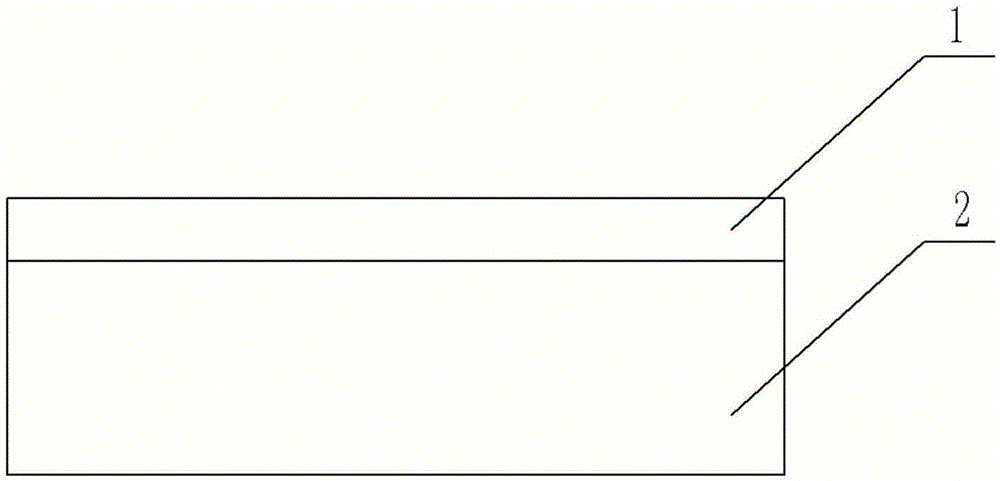Thermal conductive member and preparation method thereof
A technology of heat-conducting components and heat-conducting layers, applied in chemical instruments and methods, modification through conduction heat transfer, cooling/ventilation/heating transformation, etc., can solve problems such as low installation accuracy and difficult disassembly and assembly of heat-conducting gaskets, and achieve friction Small resistance, guaranteed installation accuracy, convenient installation and adjustment
- Summary
- Abstract
- Description
- Claims
- Application Information
AI Technical Summary
Problems solved by technology
Method used
Image
Examples
Embodiment 1
[0030] A heat-conducting member, the non-adhesive layer comprises the following components by mass: 60 parts by mass of a phase change material, 450 parts by mass of an Al filler with a particle size of 20 μm, and 200 parts by mass of a ZnO filler with a particle size of 2 μm;
[0031] The conductive layer comprises the following components by mass: 14.5 parts by mass of polysiloxane, 26 parts by mass of Al with a particle size of 5 μm 2 o 3 and 50 parts by mass of Al with a particle size of 40 μm 2 o 3 .
[0032] A method for preparing a heat conducting member, comprising the following steps:
[0033] Step 1: The phase change material, the Al filler with a particle size of 20 μm, and the ZnO filler with a particle size of 2 μm were stirred and mixed by planetary stirring to form a mixture. The stirring temperature was 110° C. and the stirring time was 120 minutes;
[0034] Step 2: The mixture prepared in step 1 is calendered to form a non-adhesive layer, and the thickness...
Embodiment 2
[0039] A heat conducting member as described in Embodiment 1, this embodiment has the following differences: the non-adhesive layer includes the following components by mass: 20 parts by mass of phase change material, 300 parts by mass of Al filler with a particle size of 5 μm and 100 parts by mass of Al with a particle size of 0.5 μm 2 o 3 filler;
[0040] The conductive layer comprises the following components by mass: 10 parts by mass of polysiloxane, 10 parts by mass of Al with a particle size of 5 μm and 90 parts by mass of Al with a particle size of 25 μm 2 o 3 .
[0041] A method for preparing a heat conducting member, comprising the following steps:
[0042] Step 1: The phase change material, the Al filler with a particle size of 5 μm, and the Al filler with a particle size of 0.5 μm 2 o 3 The filler is stirred and mixed by planetary stirring to form a mixture, the stirring temperature is 150°C, and the stirring time is 180 minutes;
[0043] Step 2: The mixture ...
Embodiment 3
[0048] A heat conduction member as described in Embodiments 1 and 2. This embodiment has the following difference: the non-adhesive layer includes the following components by mass: 50 parts by mass of phase change material, 500 parts by mass of Al filler and 200 parts by mass of ZnO filler with a particle size of 0.5 μm;
[0049] The conductive layer comprises the following components by mass: 15 parts by mass of polysiloxane, and 50 parts by mass of AlN with a particle size of 40 μm.
[0050] A method for preparing a heat conducting member, comprising the following steps:
[0051] Step 1: The phase change material, the Al filler with a particle size of 15 μm, and the ZnO filler with a particle size of 0.5 μm were stirred and mixed by planetary stirring to form a mixture. The stirring temperature was 130° C. and the stirring time was 160 minutes;
[0052] Step 2: The mixture prepared in step 1 is calendered to form a non-adhesive layer, and the thickness of the non-adhesive l...
PUM
| Property | Measurement | Unit |
|---|---|---|
| thickness | aaaaa | aaaaa |
| particle diameter | aaaaa | aaaaa |
| particle diameter | aaaaa | aaaaa |
Abstract
Description
Claims
Application Information
 Login to View More
Login to View More - R&D
- Intellectual Property
- Life Sciences
- Materials
- Tech Scout
- Unparalleled Data Quality
- Higher Quality Content
- 60% Fewer Hallucinations
Browse by: Latest US Patents, China's latest patents, Technical Efficacy Thesaurus, Application Domain, Technology Topic, Popular Technical Reports.
© 2025 PatSnap. All rights reserved.Legal|Privacy policy|Modern Slavery Act Transparency Statement|Sitemap|About US| Contact US: help@patsnap.com

